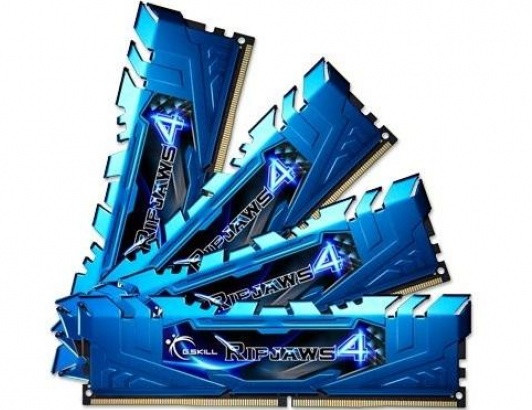Having a processor worth 500 dollars, or 1000 dollars, in the case of the even more expensive Core i7, and some DDR4 2133 memories doesn’t seem like a good idea. With proper memories we’ll make better use of any overclocking we do in our system and, if we have the right motherboard, taking advantage of high frequency memories is as simple as activating the right overclocking XMP profiles. Clicking and enjoying the extra performance.
Technical Specifications
This is the case of the modules that we analyze today. A high speed kit from GSkill with four units of 4GB of capacity that form a memory bus of 256-Bit DDR4 capable of developing bandwidths of memory of the entry-level graphics card. This can be translated into an optimization of the processing capacity of the CPU until the point of winning, in adequate programs, a 5-10% of performance.
GSkill currently has one of the widest and most varied DDR4 memory catalogues. It’s an expensive memory that has begun with a wide variety of frequencies that go from 2133MHz, which is the basic and standard, to frequencies of 3400MHz as factory default and overclocking that exceeds 4500MHz.
These F3-3000C15 memories from GSKill are at the intermediate point but aren’t cheap at all. These high-speed 16GB, in four modules of 4GB, cost almost 300 dollars. Getting 32GB of DDR4 memory at frequencies somehow inferior, such as 2400MHz, costs around 400 dollars in the best-case scenario. If we buy for frequencies of 3000 and up, the prices soar; but truly, for the highest models of the Intel range, I think their use is fair and necessary.
These modules have benefits above those we can find in modules certified by the JEDEC but are adapted to also work on less aggressive frequencies. They can work on voltage ranges of 1.2v (at 2133MHz) even though their most aggressive profile (XMP 2.0) requires 1.35v to work properly. Latencies are pretty conventional with CAS 15-15-15-35 and a 2T “command rate” which is the same, two cycles that are also usual in DDR4 memories.
It doesn’t have intermediate profiles and it doesn’t need them because its environment is to work with motherboards that are capable and adapted to its potential. However, a standard SPD profile that helps early beginnings and the proper configuration of the motherboard is always appreciated.
GSkill adds a heatsink to the memories that we can find in red, blue and gray colors. It’s more of a decoration than a real need since without it, these memories could work perfectly. In fact they work at very normal environment temperatures at 30-45 degrees even during a test that stresses the data bus.
Performance and overclocking
The benefits of these memories is that they allow us to reach speeds high above conventional, but if we want to take real advantage the improvement can be of around 5-6%. We’ve been able to reach 3200MHz without the necessity of adjusting voltages that for me are fundamental if we want the memories to suffer the least stress possible, especially if we want them to last the entire life of our PC. With these frequencies of overclocking, and no extra refrigeration, we get excellent results for a PC in which we can work the 24 hours of the day.
In our tests we’ve obtained conventional results with this type of memories, in its usual Quad-channel configuration, as we have already seen on other occasions. Now we have also done a test of difference of performance in Cinebench, which is not exactly a test of memory performance but notably benefits the improvement of the bandwidth.
Test Equipment:
Processor: Intel Core i7-5960X
Motherboard: ASUS Rampage Extreme V
Memories: GSkill DDR4 F43000C15 4×4 Quad Channel.
Power Supply: Seasonic Platinum Series 1200w
Bandwidth:Cinebench R15 Performance:
A 2400MHz performance is of 1491CB. The processor is held to 4125MHz.
Increasing the frequency of RAM to 3000MHz, the performance improvement achieves 1610CB. Only with increased RAM bandwidth.
Analysis and conclusion
GSkill offers a kit of high-speed memories at a competitive price that is easily configurable, taking advantage of its XMP 2.0 profile as a base for overclocking. We can increase the frequency of our processor above 4GHz and keep memory frequencies at more than interesting levels with which we can take advantage of every exceptional high-range benefit from Intel.
These are the memories with which we obtain realistic objectives of quality and without the necessity of using high voltages as we’ve suffered with other models that we have analyzed during these past months.








